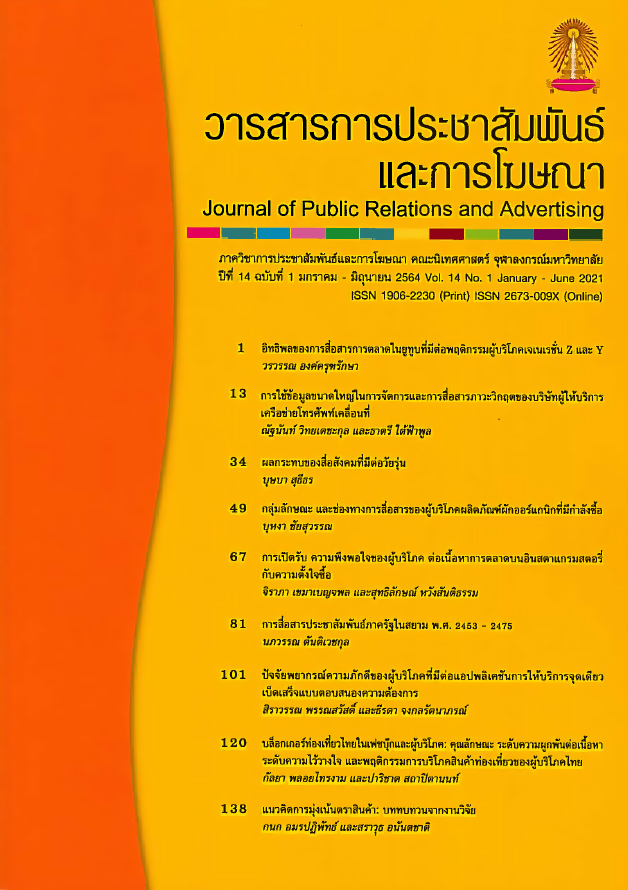Using Big Data in Crisis Management and Communications of Mobile Service Providers
Main Article Content
Abstract
This research on the application of big data in crisis management and communications by mobile service providers is conducted as a qualitative research. The aim of this study are to explain the big data application in crisis management and communications of mobile service providers as well as to examine the problems and obstacles concerning this issue. The research utilized in-depth interview method in which the interviewees were chosen on the basis of purposive sampling, dividing the interviewees into 3 distinct groups.
The result shows that there are 4 issues in regard to the big data usage in crisis management and communications of mobile service providers which are (1)the big data is applicable in every period of a particular crisis which are the pre-crisis, the crisis event and the post-crisis periods; (2)the crew who is in charge of the big data usage in crisis management focusing on communications and information technology; (3)the cooperation between the organizations and the agencies when the amount of big data inevitably exceeds the capacity of organization’s management and (4)the growing role of big data in crisis management and communications in the future based on the prediction of the existing big data.
In addition, the research finds that there are problems and obstacles risen from the big data usage in crisis management and communications which are (1)the practical inefficiency of the big data; (2)the difficulty in predicting human behaviors; (3) the growing numbers of chatting application users; (4)the trusting in artificial intelligence; (5)the capability of the big data users and (6)the duration of process learning and practicing.
Article Details
References
ธนชาต ฤทธิ์บำรุง. (2562). 4 Levels of Data Analytics Maturity — 4 ขั้นของ Data Analytics. วันเข้าถึงข้อมูล 27 กรกฎาคม 2562, แหล่งที่มา https://medium.com/@thanachart.rit/4-levels-of-data-analytics-maturity-4-ขั้นของ-data-analytics-580d04302f74
ประภาพร กุลลิ้มรัตน์ชัย. (2561). การเข้าสู่ยุคของวิทยาศาสตร์ข้อมูล (Entering into Era of Data Science). วารสารมหาวิทยาลัยอีสเทิร์นเอเชีย ฉบับวิทยาศาสตร์และเทคโนโลยี, 12(2), 120-129.
ปรีดิ์เปรม ชัยกิจ. (2559). การจัดการภาวะวิกฤตบนสังคมออนไลน์ของบริษัทผู้ให้บริการเครือข่ายโทรศัพท์เคลื่อนที่. วิทยานิพนธ์ปริญญามหาบัณฑิต สาขาวิชานิเทศศาสตร์ จุฬาลงกรณ์มหาวิทยาลัย.
พนม คลี่ฉายา. หัวหน้าภาควิชาการประชาสัมพันธ์, จุฬาลงกรณ์มหาวิทยาลัย. (19 ธันวาคม 2562). สัมภาษณ์.
เยาวลักษณ์ ชาติบัญชา และ โสภณ เพิ่มศิริวัลลภ. (2559). คำถามที่พบบ่อย (FAQ) เกี่ยวกับ Big data และ Data analytics. วันเข้าถึงข้อมูล 27 กรกฎาคม 2562, แหล่งที่มา http://www.thai-iod.com/imgUpload/file/Library/IT%20Governance/______________(FAQ)%20_________%20Big%20Data%20___%20Data%20analytics%20-%20IOD%20Boardroom%20Vol_48%20Issue%205_2016.pdf
วิสิทธิ์ เวียงนาค. (2561). Building Arduino-Based Projects for The INTERNET OF THINGS. วันเข้าถึงข้อมูล 27 กรกฎาคม 2562, แหล่งที่มา https://www.facebook.com/IOTthailland/posts/1326604670815070/
อสมา กุลวานิชไชยนันท์. (2561). BIG DATA SERIES I: Introduction to a Big Data Project ปฐมบทในการทำโปรเจค
บิ๊กดาต้า. กรุงเทพมหานคร: บริษัท พราวเพลส (2002) จำกัด.
Beath, C., Becerra-Fernandez, I., Ross, J., & Short, J. (2012). Finding Value in the Information Explosion. MIT Sloan Management Review, 53(4), 18-20.
Byun, C., Arcand, W., Bestor, D., Bergeron, B., Hubbell, M., Kepner, J., . . . Yee, C. (2012). Driving big data with big compute. Paper presented at the 2012 IEEE Conference on High Performance Extreme Computing (HPEC), Waltham, MA.
Coombs, W. T. (2007). Ongoing crisis communication: Planning, Managing, and Responding. Thousand Oaks, CA: SAGE Publications.
Coombs, W. T. (2010). Sustainability: A New and Complex “Challenge” for Crisis Managers. International Journal of Sustainable Strategic Management, 2(1), 4-16.
Cutlip, S. M., Center, A. H., & Broom, G. M. (2006). Effective Public Relations (9th ed.). Upper Saddle River, NJ: Pearson Prentice Hall.
Cuzzocrea, A. (2013). Analytics over Big Data: Exploring the Convergence of Data Warehousing, OLAP and Data-Intensive Cloud Infrastructures. Paper presented at the 2013 IEEE 37th Annual Computer Software and Applications Conference (COMPSAC), Kyoto, JP.
Dijk, J. v. (2012). The Network Society (3rd ed.). London: Sage Publications.
Greengard, S. (2013). Seeing the big picture. Communication of the ACM, 56(12), 16–18.
Gruber, D., Smerek, R., Thomas-Hunt, M., & James, E. (2015). The real-time power of Twitter: Crisis management and leadership in an age of social media. Business Horizons, 58(2), 163-172.
Hosseinali-Mirza, V., Marcellis-Warin, N. d., & Warin, T. (2015). Crisis Communication Strategies and Reputation Risk in the Online Social Media Environment. International Journal of Business and Social Science, 6(5), 7-21.
Katal, A., Wazid, M., & Goudar, R. H. (2013). Big data: Issues, challenges, tools and Good practices. Paper presented at the 2013 Sixth International Conference on Contemporary Computing (IC3), Noida, IN.
Ki, E.-J., & Nekmat, E. (2014). Situational crisis communication and interactivity: Usage and effectiveness of Facebook for crisis management by Fortune 500 companies. Computers in Human Behavior, 35, 140-147.
Lee, J. (2017). Data Engineer, Data Analyst, Data Scientist — What’s the Difference? Retrieved July 29, 2019, from https://www.dataquest.io/blog/data-analyst-data-scientist-data-engineer/
Owyang, J. (2011). Social Media Crises on Rise: Be Prepared by Climbing the Social Business Hierarchy of Needs. Retrieved July 29, 2019, from http://web-strategist.com/blog/2011/08/31/report-social-media-crises-on-rise-be-prepared-by-climbing-the-social-business-hierarchy-of-needs/
Syme, C. (2014). Monitoring Social Media to Prevent a Crisis. Retrieved July 29, 2019, from https://www.socialmediatoday.com/content/monitoring-social-media-prevent-crisis
Veil, S. R., Buehner, T., & Palenchar, M. J. (2011). A Work-In-Process Literature Review: Incorporating Social Media in Risk and Crisis Communication. Journal of Contingencies and Crisis Management, 19(2), 110-122.


